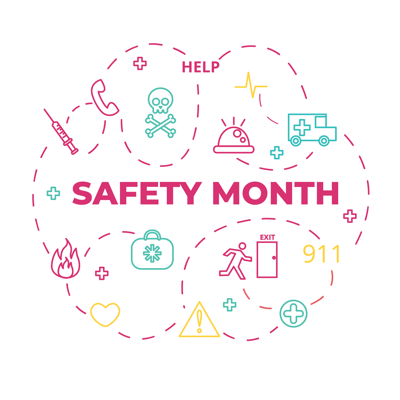 Ready for your employees to play it safe?
Ready for your employees to play it safe?
June is National Safety Month and a perfect opportunity to promote safety in the workplace. The most common workplace injuries include overexertion, slips, trips, and falls, and dangerous contact with equipment.
A look at safety numbers in the workplace:
- Every 7 seconds, an employee is injured at work
- In 2017, 104,000,000 production hours were lost due to injury
- 5,147 workers died on the job in 2017
- 25.6% of all workplace injuries are falls or trips
According to the National Safety Council, the most common injuries keeping workers at home include sprains, strains, pain, cuts, and lacerations. Keep your employees safe by conducting proper safety trainings, keeping safe work spaces, and educating them weekly.
Luckily, education can start at any time.
Here’s a look at 30 days of safety topics to share with your employees this month:
Prevent Falls
Day 1
Keep it clean - Keep work spaces and walkways free of boxes and cords. Any tripping hazards that could cause yourself or others to trip, tape down or move to another area.
Day 2
Use it right Rolling chairs are not ladders. Use the proper safety equipment for the job. If needed, wear safety helmets and harnesses to avoid falls and injury from high heights.
Day 3
Clean up - Wipe up spills immediately to avoid slipping.
Day 4
Keep surfaces safe - Use welcome mats or carpets on solid floors that can become slippery due to rain or other nearby water sources.
Day 5
Hang on - Use handrails in staircases and watch your step as you climb and descend stairwells. Never run, jump, or skip stairs.
Day 6
Watch out - Avoid sidewalk edges and cracks, parking bumpers, and speed bumps that could cause you to trip and lose your balance.
Day 7
Don’t get tripped up - Keep outside walking areas free from planting debris and tripping hazards.
Prevent Ergonomic Injuries
Day 8
Keep your feet flat - Your feet should touch the floor while sitting in your office chair. Your knees should be slightly higher than the seat of the chair.
Day 9
Set your mouse in the right position - Your computer mouse should be next to the keyboard. Do not have it higher or lower as this can cause strain on your wrist, elbows and fingers.
Day 10
Get adjusted - Make your workstation adjustable to fit your needs. Proper seating, posture, and equipment can reduce back injuries.
Day 11
Stretch - Take stretch breaks to minimize tension and get blood flowing. Sitting too long and too often can cause back pain, reduce blood flow, and increase the risk for obesity.
Day 12
Use the proper tools - Limit physical stress by using document holders, lamps, wrist pads, etc. when working for long periods of time at a computer station or desk.
Prevent Struck-By and Caught-Between Injuries
Day 13
Stack with care - Ensure materials are stacked safely to minimize collapse. Don’t stack objects too high.
Day 14
Shut it - Close desk drawers and cabinets when not in use to avoid injuring body parts by an unexpected run-in.
Day 15
Tools of the trade - Ensure all work tools are guarded correctly to reduce risk of injury.
Day 16
Look out - Be aware of vehicles in your vicinity as you cross streets, parking lots, and work areas where vehicles are moving.
Day 17
Vehicle safety features - Work vehicles should have buzzers, beepers, traffic cones, etc. Whatever safety measures are needed to conduct safe business, be sure to use those when you’re using a company vehicle.
Learn to Recognize and Anticipate Hazards
Day 18
Be aware - Pay attention to your surroundings. Watch out for falling objects, misplaced work tools, environmental hazards, and more.
Day 19
Look around corners - Watch out when walking around corners and other areas that could lead to collisions with objects or co-workers — especially if you’re carrying dangerous tools or heavy objects.
Day 20
Pay attention to your body - Don’t over-exert or strain yourself. Take breaks as needed.
Day 21
Wear appropriate attire - Dress for your work environment and take into account heat or cold. Additionally, remember any safety uniforms or other gear needed to perform the job safely.
Day 22
Drink up - Stay hydrated when working, especially in hot temperatures. Aim for eight 8-ounce glasses per day. Drinking water throughout the day will prevent dehydration, which can cause dizziness, headaches, and nausea.
Day 23
Anticipate your medical conditions - Have medications and Epipens handy.
Day 24
Set timers - Schedule reminders to take medications at proper intervals so you don’t miss a dosage.
Stay Awake and Alert
Day 25
Settle in for solid slumber - There are several things that can disrupt sleep that you should try to avoid before bedtime. These include blue light from TVs and phones, caffeine, and alcohol.
Day 26
Get quality sleep - Improve sleep by keeping bedrooms cool and dark. The ideal sleeping temperature is 67 degrees Fahrenheit.
Day 27
See a doc: Persistent fatigue could be related to sleep disorders or other medical conditions. If your snoring is waking you up, or you’re told you sound like you’re choking in your sleep, you may need to do a sleep study to rule out issues like sleep apnea.
Day 28
Shake things up - If your schedule is too tiring, see if your supervisor can change it. Disrupting your sleep patterns on a regular basis can throw your health out of whack.
Day 29
Know your drug effects - Any level of impairment is too much at work. Opioids in particular are known for being addictive. Don’t be afraid to ask for help if you think you may be using pain meds too often.
Day 30
Stay sober - Drinking, drugs, and work don’t mix. Don’t take a chance of injury to yourself or others by working when you’re impaired.
Keep Workers Safe all Year
Safety should be a priority all year, not just in June.
Take the time to educate your employees with these safety month topics.
As an employer, there are plenty of Occupational Safety and Health Act (OSHA) safety posters your office can print off for free. Additionally, holding multiple weekly, quarterly, and yearly safety trainings can increase employees’ safety knowledge.
For appropriate departments, share “days without incident” reports to encourage employees to keep using safety measures in their respective roles.
By educating employees on a regular basis — even the most experienced ones — you minimize the risk of accidents, injuries, and even death. Pause and reflect now on how to best cover your workplace’s most important safety topics with employees.
It’s much better to arm your staff now with the knowledge that could save their health and life by understanding best workplace safety practices before accidents happen.
How do you plan to educate employees during National Safety Month? Share in the comments below!



